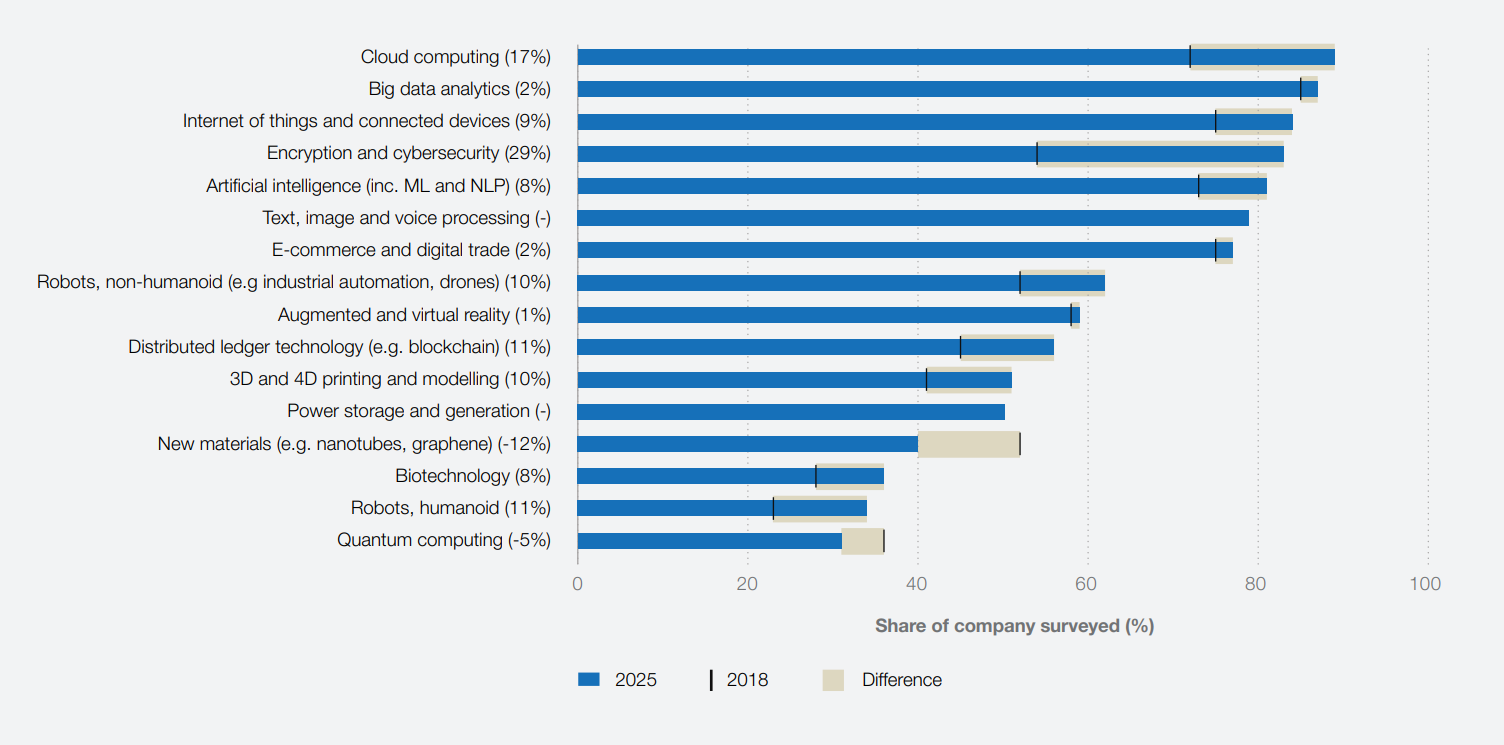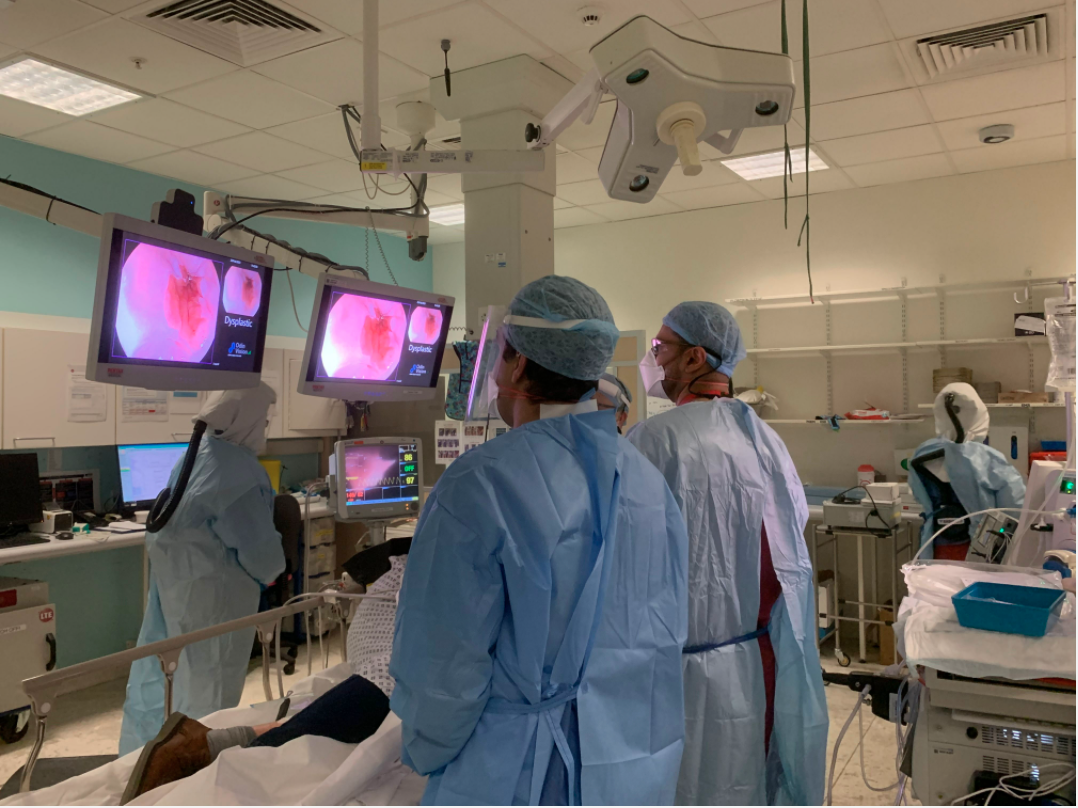- With AI adoption on the rise, the technology is addressing a number of global challenges.
- Artificial intelligence is being used to help crack down on illegal activities.
- It is helping to tackle overfishing in our ocean.
- And it is even being used to address the issue of gender imbalance.
In the wake of the pandemic, a growing number of businesses are speeding up plans to adopt AI and automation, according to the World Economic Forum’s Future of Jobs Report 2020.
As humans and technology increasingly work together, here are five examples of the range of applications for artificial intelligence and where it might do good.
 "lazy", :class=>"", :alt=>"a graph showing AI is one of the top five technologies likely to be adopted by companies by 2025."}” use_picture=”true”>
"lazy", :class=>"", :alt=>"a graph showing AI is one of the top five technologies likely to be adopted by companies by 2025."}” use_picture=”true”>
AI is one of the top five technologies likely to be adopted by companies by 2025.
Image: World Economic Forum: Future of Jobs Report 2020
Closing the net on illegal fishing
Overfishing can deprive millions of people of their livelihood and billions of people of the food they need.
OceanMind is a UK-based organization fighting back against overfishing and illegal fishing using AI.
Pulling data from a variety of sources, including on-board collision-avoidance transmitters, radar and satellite imagery, and phone signals, OceanMind can track thousands of vessels around the world. Analyzing all that data, to ensure fishing craft are only operating in areas where they are allowed, is only possible thanks to AI and machine-learning algorithms.
When a ship is detected in waters where it isn’t licensed to operate, its location and details can be sent straight to local law enforcement or coast guard agencies to effect a timely intervention.
Tackling human trafficking
There could be as many as 45 million enslaved people around the world right now. Many of them will have been the victims of human trafficking, which is one of the most profitable criminal undertakings of our time.
The Global Emancipation Network (GEN) has joined forces with Accenture, Splunk (a data analytics platform) and Graphistry (which develops easy-to-read data visualizations) to create an AI-powered human-trafficking tool.
Called Artemis, it draws in data from sources such as business licenses, and public records like credit defaults and online reviews, among others. Then it identifies businesses and individuals, which it calculates to be those most likely to be involved in human trafficking. Artemis can send alerts to law enforcement agencies, triggering further investigations.
Fighting gender imbalance in the media
Ensuring a more equitable range of voices and faces in the media can only be achieved through an accurate assessment of where change is needed. That’s the view of Swiss multimedia publishing business Ringier, which is using AI to check the gender bias of its output.
The tool it has developed is called EqualVoice and it analyzes the balance of men and women that appear in the articles, features, and clips that appear across the publisher’s brands.
The tool tracks gender representation in headlines, photos and captions, as well as throughout the main body of published stories. A report from the World Association of News Publishers says some Ringier-owned titles have achieved a 50:50 female:male split in their readership and that its next goal is to improve gender parity in its newsrooms.
Helping diagnose cancer
Less than 20% of people diagnosed with cancer of the oesophagus will live beyond five years, and it is one of the six less survivable cancers.
If caught early, the prognosis is encouraging – the cancer can be successfully treated in 90% of such cases. However, it is notoriously difficult to diagnose early, which contributes to the low survival rate.
Clinicians at the University College London Hospital in the UK, have been working with technologists to develop a tool for the early detection of oesophageal cancers. Called CADU, the AI-based tool analyzes images of the inside of a patient’s oesophagus – captured with a tiny camera lowered down a person’s throat by a physician.
As many as 25% of oesophageal cancers are not detected via traditional diagnosis. But CADU has been trained with many thousands of images showing cancerous tissue and is being used to spot the subtlest of early changes in real-time, while the endoscopic camera is in use.
 "lazy", :class=>"", :alt=>"these doctors are using an AI programme to assess for cancer of the oesophagus"}” use_picture=”true”>
"lazy", :class=>"", :alt=>"these doctors are using an AI programme to assess for cancer of the oesophagus"}” use_picture=”true”>
Doctors using an AI programme to assess for cancer of the oesophagus.
Image: Odin Vision/University College London
The World Economic Forum was the first to draw the world’s attention to the Fourth Industrial Revolution, the current period of unprecedented change driven by rapid technological advances. Policies, norms and regulations have not been able to keep up with the pace of innovation, creating a growing need to fill this gap.
The Forum established the Centre for the Fourth Industrial Revolution Network in 2017 to ensure that new and emerging technologies will help—not harm—humanity in the future. Headquartered in San Francisco, the network launched centres in China, India and Japan in 2018 and is rapidly establishing locally-run Affiliate Centres in many countries around the world.
[embedded content]
The global network is working closely with partners from government, business, academia and civil society to co-design and pilot agile frameworks for governing new and emerging technologies, including artificial intelligence (AI), autonomous vehicles, blockchain, data policy, digital trade, drones, internet of things (IoT), precision medicine and environmental innovations.
Learn more about the groundbreaking work that the Centre for the Fourth Industrial Revolution Network is doing to prepare us for the future.
Want to help us shape the Fourth Industrial Revolution? Contact us to find out how you can become a member or partner.
Tracking and responding to COVID-19
AI systems had detected the outbreak of a new, previously unknown pneumonia-like illness in China well before the world realized it was in the midst of a pandemic.
AI-powered early warning systems for disease and infection draw in data from news sites and online sources of information to spot epidemiological patterns; they can then trigger alerts and help healthcare services get ready.
The power of AI has also been used to help assess the likely efficacy of specific drugs or treatments for COVID-19 symptoms.
Meanwhile, businesses including IBM, Amazon, Google and Microsoft, are donating their cloud computing resources to enable research institutions to carry out high-performance computational calculations. This has even been mirrored by many private individuals who have joined the Folding@home initiative and made their personal computers available to help collaborative computing efforts take place in the push to manage the pandemic.
License and Republishing
